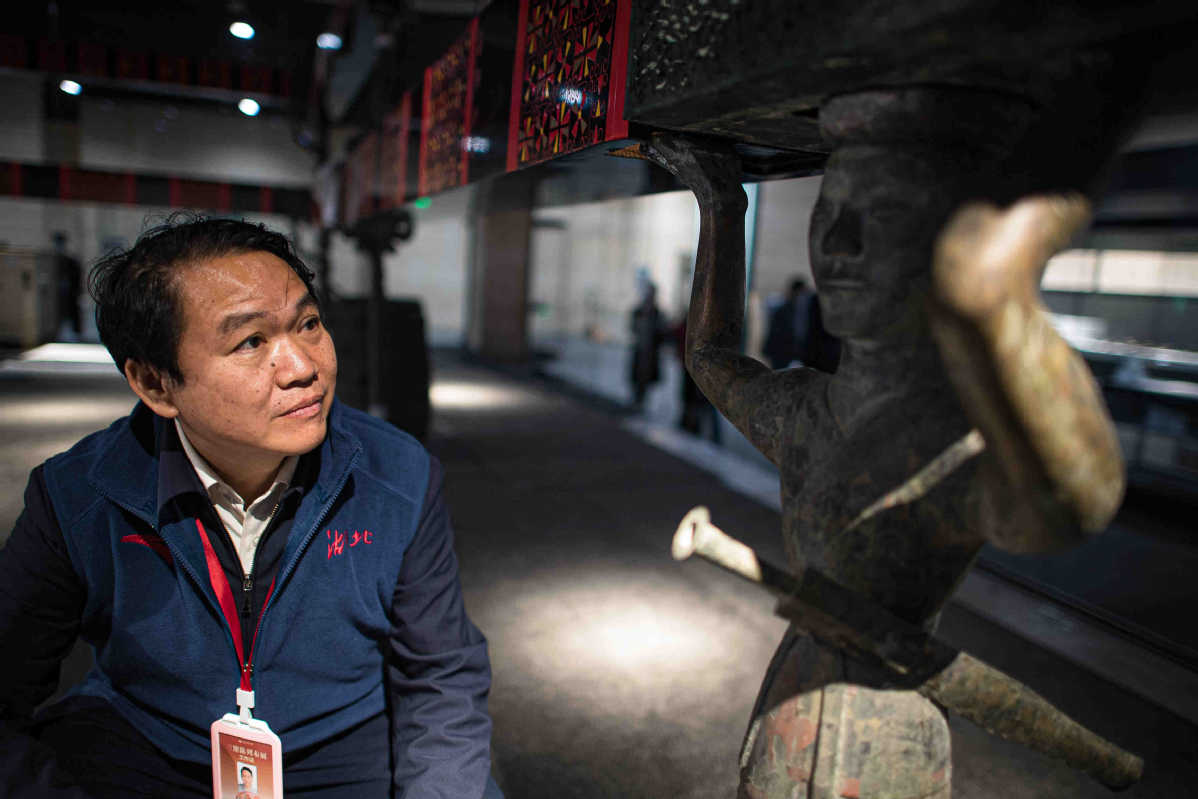Archaeologist shares discoveries as storyteller of ancient cultures
18:48, October 14, 2022 China Daily

Fang Qin checks the condition of relics at the Hubei Provincial Museum in Wuhan, Hubei province, in October 2021. XIAO YIJIU/XINHUA
When Fang Qin was a student in the archaeology department of Peking University in 1989, he took part in a team that looked for traces of buildings used by the elite, such as kings or military officials, at the Shijiahe site in Tianmen, Hubei province — a prehistoric site dating back about 5,900 years. They failed due to the limits of technology at the time.
Now a team leader, Fang works at the same site, and this year he found many pieces of relics that proved there were indeed houses built for elites at the Shijiahe site. The findings offer a comprehensive understanding of a civilization whose culture continued from 5,900 to 3,800 years ago.
"It's just like a mission for me to resume the work I left unfinished 33 years ago," said Fang, director of the Hubei Provincial Institute of Cultural Relics and Archaeology and a delegate to the upcoming 20th National Congress of the Communist Party of China, which will convene on Sunday in Beijing.
For decades, Fang has devoted himself to archaeology and decoding the history of thousands of years ago to unveil the glory of ancient cultures in the middle reaches of the Yangtze River.
Fang and his team spent 10 years exploring the history of the Zeng state, a small yet mysterious kingdom of the early Warring States Period (475-221 BC), at a site found in Suizhou, Hubei, where many bronze bells were unearthed. The highlight is a set of chime bells weighing over 2,000 kilograms that were discovered in the tomb of Marquis Yi of the Zeng state.
"It's very common for archaeologists to spend years or decades on a single site to decode a glorious civilization," Fang said.
In addition to his work as an archaeologist, Fang is an active promoter of ancient cultures as the director of the Hubei Provincial Museum in Wuhan.
In 2020, the museum presented an exhibition featuring hundreds of precious relics from the Zeng state. It attracted tens of thousands of visitors and was listed by the National Cultural Heritage Administration as one of the year's top 10 exhibitions.
When the museum opened a new exhibition building to the public in December last year, Fang curated a series of archaeology shows to demonstrate various cultures that existed in Hubei thousands of years ago, drawing more than 10,000 visitors per day.
"It's important to tell the public what we found at the archaeological sites. A good archaeologist should also be a good cultural storyteller in the age of information," the 53-year-old museum director said.
Fang was among the first museum directors to livestream museum shows in China.
In 2020, when COVID-19 hit Wuhan, Fang lived in the museum for nearly three months in order to guard the precious items housed there. To allow people who were confined to their homes amid the epidemic to "visit" the museum, Fang livestreamed a show online that attracted about 30 million viewers.
"As an archaeologist, I feel very happy to see that people are interested in our culture and history. To visit museums, either online or offline, has become part of people's entertainment," he said.
In the past few years, he has been invited to appear on many TV shows and programs, including CCTV's The Nation's Greatest Treasures, to tell the stories of cultural relics to a wider audience.
The stories have also been shared overseas via cultural exchanges. Fang has held shows in the United States, Russia, Italy and India regarding prehistoric Chinese cultures.
"In the digital era, an archaeologist is no longer lonely," Fang said. "We bear the mission to spread our culture and let more people know the stories with the help of new tech."

